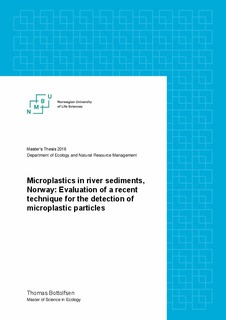| dc.contributor.advisor | Schneider, Susanne | |
| dc.contributor.author | Bottolfsen, Thomas | |
| dc.coverage.spatial | Norway | nb_NO |
| dc.date.accessioned | 2017-04-03T13:43:45Z | |
| dc.date.available | 2017-04-03T13:43:45Z | |
| dc.date.issued | 2016 | |
| dc.identifier.uri | http://hdl.handle.net/11250/2436633 | |
| dc.description.abstract | Plastic debris is one of the more visible pollutants in the aquatic environment. While much attention has been given to marine environments, fewer studies have explored the fate of plastics in freshwater environments. This is surprising since most of the plastic that is found in the oceans has a terrestrial source and is transported to the sea by rivers and estuaries. Due to their durability and long degradation time many polymers may last for years in the environment and continuously become more fragmented until only microscopic particles remain.
Presently there are no standardized techniques for quantifying microplastic particles from sediments. However, a recently proposed technique intended for marine beach sediments is an elutriation device (ED). Elutriation is a separation technique that entails an upward stream of gas or liquid to isolate lighter particles from heavier ones. In this thesis, an ED was constructed and evaluated for use in river sediments by testing the effects of water flow and aeration intensity on capture of supplemented microplastic pellets. In addition, microplastic particles from six sites in an urban stream in Oslo (Alna river) were quantified after sediment volume reduction with the ED. This thesis documents for the first time the occurrence of microplastics (< 5 mm) in Norwegian river sediments.
To separate microplastics from sediments a water flow of 300 L/h-1 and an aeration intensity of 20 L/min-1 was found to be optimal for the ED. Polymers encountered that have a 1.2 g/cm-3 or higher density may not be detectable using this elutriation technique. 35 particles from the Alna river were identified by Fourier transform infrared spectroscopy (FT-IR) as plastic, synthetic polymers. 43% of the particles were microplastic, 51% were mesoplastic (5-25 mm) and 6% were macroplastic (> 25 mm). Polyethylene was the most common polymer found (34%), then in descending order polyethylene terephthalate (PET), polyurethane (PUR), polypropylene (PP) and polystyrene (PS). 17% of the polymers were so-called “road dust”, i.e. they represent remains of auto paint surfaces and car tire rubbers. All polymers found in this study are consistent with similar studies in freshwater environments around the world. These findings can be groundwork for further studies on microplastic pollution in Norwegian freshwater environments. | nb_NO |
| dc.description.sponsorship | Norwegian Institute of Water Research | nb_NO |
| dc.language.iso | eng | nb_NO |
| dc.publisher | Norwegian University of Life Sciences, Ås | nb_NO |
| dc.rights | Attribution-NonCommercial-NoDerivatives 4.0 Internasjonal | * |
| dc.rights.uri | http://creativecommons.org/licenses/by-nc-nd/4.0/deed.no | * |
| dc.subject | Microplastics | nb_NO |
| dc.subject | Rivers | nb_NO |
| dc.subject | Sediment | nb_NO |
| dc.subject | Freshwater | nb_NO |
| dc.subject | Density separation | nb_NO |
| dc.subject | Elutriation device | nb_NO |
| dc.title | Microplastics in river sediments, Norway : evaluation of a recent technique for the detection of microplastic particles | nb_NO |
| dc.type | Master thesis | nb_NO |
| dc.subject.nsi | VDP::Matematikk og Naturvitenskap: 400 | nb_NO |
| dc.source.pagenumber | 36 | nb_NO |
| dc.description.localcode | M-ECOL | nb_NO |

